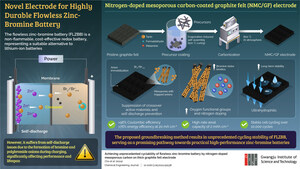Gwangju Institute of Science and Technology Scientists Improve the Power Output of Triboelectric Nanogenerators with Carbon Particles
Mesoporous carbon spheres facilitate charge transport and high surface charge densities in triboelectric nanogenerators for a 1300-fold higher output current
GWANGJU, South Korea, Aug. 10, 2022 /PRNewswire/ -- Most of us have felt the shock from static electricity by touching a metallic object after putting on a sweater or walking across a carpet. This occurs as a result of charge build-up whenever two dissimilar materials (such as our body and the fabric) come in contact with each other.
In 2012, scientists from the USA and China used this phenomenon, known as "triboelectric effect," to build a triboelectric nanogenerator (TENG) that converts unused mechanical energy into useful electrical energy. Their device consisted of two triboelectric polymer films with metallic electrodes, which, when brought together and separated, resulted in charge separation and the development of an electric voltage sufficient to power small electronic devices.
Viewed as potential sustainable energy harvesters, efforts have been made to enhance the power output of TENGs by injecting charges to the surface of triboelectric films. However, charge recombination in the electrode and charge repulsion on the surface of the material prevents them from achieving high surface charge densities.
Against this backdrop, a team of researchers led by Professor Chanho Pak from the Gwangju Institute of Science and Technology (GIST) in South Korea developed, in a recent study, a charge-confinement layer that manages the transfer of injected charges between the triboelectric film and the electrode to improve the charge density on the surface of the triboelectric film. This paper was made available online on 16 March 2022 and was published in Volume 6 Issue 5 of Small Methods on 18 May 2022.
"In the design of high-performance TENGs, it is critical to transport the charge on the surface to a deep position while reducing charge recombination," says Prof. Pak. To make the layers, the researchers used electrospun mesoporous carbon spheres together with layers of polyvinylidene fluoride (PVDF) and nylon. The carbon spheres, which trap charges on the surface, were arranged in ascending order of their specific surface areas, making for a gradient charge-confinement layer. As a result of this gradient arrangement, the injected charges could drift towards the electrode but were confined just before reaching it. "The layers transport as well as confine the charges," explains Prof. Pak.
By transporting the charges away from the surface, the layers prevent injected charges from accumulating and repelling each other on the surface of the triboelectric material, allowing it to hold more charge. Additionally, confining the charges close to the electrodes prevents charge loss due to recombination, resulting in a triboelectric surface with a higher charge density.
With the addition of charge-confining layers, the researchers improved the output voltage and current of the TENG by 40 and seven times, respectively. Additionally, by combining a cylindrical TENG and an electromagnetic generator, they achieved a dramatic 1300-fold enhancement in output current.
"With these promising results, TENGs could one day be powerful enough to serve as sustainable energy harvesters as well as power wearable devices of the future," says Prof. Pak.
And we can't wait to find out!
Title of original paper: Controllable Triboelectric Series Using Gradient Positive and Negative Charge-Confinement Layer with Different Particle Sizes of Mesoporous Carbon Materials
Journal: Small Methods
DOI: https://doi.org/10.1002/smtd.202101545
About the Gwangju Institute of Science and Technology (GIST)
Website: http://www.gist.ac.kr/
Contact:
Seulhye Kim
82 62 715 6253
[email protected]
SOURCE Gwangju Institute of Science and Technology

WANT YOUR COMPANY'S NEWS FEATURED ON PRNEWSWIRE.COM?
Newsrooms &
Influencers
Digital Media
Outlets
Journalists
Opted In





Share this article